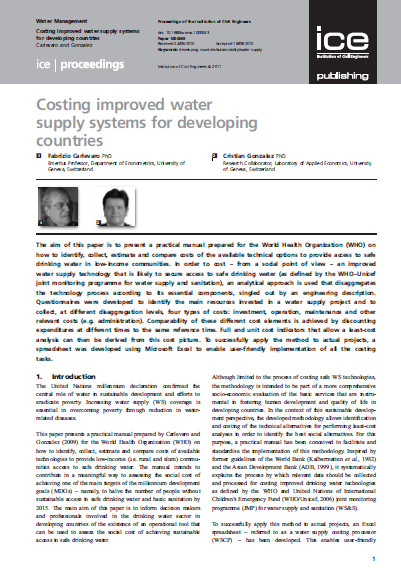Costing improved water supply systems for developping countries
 |
Évaluation économique des systèmes améliorés pour la fourniture d'eau potable dans les pays en développement
article Dec 2010 ; 12 pages
Aut. Fabrizio Carlevaro & Cristian Gonzalez
Ed. Université de Genève - Genève
Downloadable format: PdF
Downloadable from the publisher
Abstract:
The aim of this paper is to present a practical manual prepared for the World Health Organization (WHO) on
how to identify, collect, estimate and compare costs of the available technical options to provide access to safe
drinking water in low-income communities. In order to cost – from a social point of view – an improved
water supply technology that is likely to secure access to safe drinking water (as defined by the WHO–Unicef
joint monitoring programme for water supply and sanitation), an analytical approach is used that disaggregates
the technology process according to its essential components, singled out by an engineering description.
Questionnaires were developed to identify the main resources invested in a water supply project and to
collect, at different disaggregation levels, four types of costs: investment, operation, maintenance and other
relevant costs (e.g. administration). Comparability of these different cost elements is achieved by discounting
expenditures at different times to the same reference time. Full and unit cost indicators that allow a least-cost
analysis can then be derived from this cost picture. To successfully apply the method to actual projects, a
spreadsheet was developed using Microsoft Excel to enable user-friendly implementation of all the costing
tasks.
Target Audiences:
Keywords: |
cost savings (CI) (DT) (ET) (ope) , costs, tariffs (CI) (DT) (ET) (ope) , financing (CI) (DT) (ET) (ope) , research (CI) (DT) (ET) (ope) , water distribution (CI) (DT) (ET) (ope) |
Publisher/Broadcaster: |
|
Université de Genève - Genève - Switzerland |
If there is a broken link, we will be pleased to receive a message: communication@pseau.org